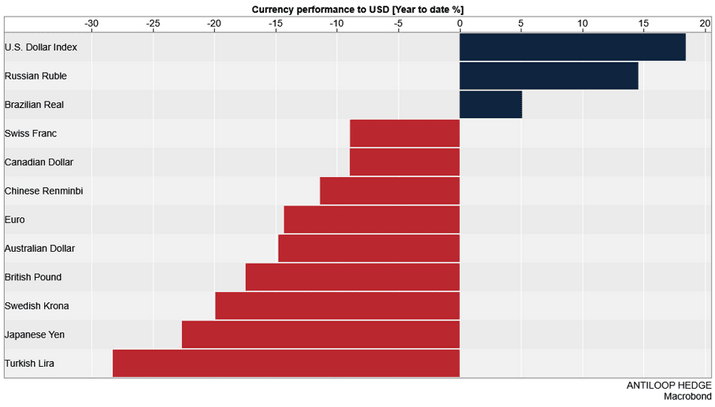How does a strong dollar affect the world economy?

Despite high inflation in the US, the US dollar has strengthened both relative to assets such as gold, but also absolutely relative to other currencies, since the beginning of the year

Despite the USA's share of global exports
falling from 14 percent in 2000 to just over 9 percent this year, 40 percent of
global exports are made in USD, which has led to a strong USD leading to many
countries importing part of the inflation. While developing countries are of course
hit the hardest, on average a 10 percent stronger USD relative to the domestic
currency has contributed to 1 percent higher inflation in the country.
When inflation in both the US and the rest of
the world took off, many thought it would lead to a weaker dollar, but since
then the opposite has happened. The simple explanation is the Federal Reserve's
crackdown on the inflation problem and that the global inflation problem led to
investors selling risk assets and reallocating to US government bonds instead.
For Americans, of course, a strong dollar is positive, but for many other
countries it leads to reduced purchasing power, higher inflation (as mentioned
above) and central banks being forced to raise interest rates more than they
originally wanted.
In recent weeks, we have seen how the global
financial system is crumbling. After the UK's mini-budget which included tax
cuts, the British pound fell and the 30-year yield rose sharply, causing
several pension funds to almost collapse, which itself led to the Bank of
England having to step in with stimulus purchases to prevent a total collapse.
Since then, the budget has been withdrawn and although the GBP has fallen
almost 20 per cent year-on-year against the US dollar, it has recovered
somewhat from the fall at the end of September.
In the EU area, inflation continues to rise
strongly and the Euro weakens, but even so, the ECB cannot raise interest rates
as strongly as the FED because most of the inflation is asset-driven from the
energy side, and further increases would most certainly force the entire EU
into a recession.
In other words, the outlook looks bleak, and
the hope investors are leaning towards is that the US economy would shrink so
sharply that the Federal Reserve is forced to make a pivot and thereby both
lower interest rates and perhaps start support purchases again. The problem
with that logic is that such an outcome is hardly positive for the economy. The
other problem is that the Fed itself has been very clear that there will not be
a change in their policies in the near term, but that they will raise interest
rates and tighten policy as much as they need until inflation falls back.
It will be a long time before we are back at
inflation levels of 2 percent or below again. Until then, we have to get used
to "higher for longer" for both interest rates and inflation. And for
those who buy risk assets based on a hope for a pivot from the Federal Reserve,
Daniel Lacalle, professor of global economics, writes:
"Investors should not care whether the
Fed pivots or not if we analyze investment opportunities based on fundamentals
and not on monetary laughing gas. Betting on a Fed pivot by adding risk to
cyclical and extremely risky assets may be an extremely dangerous position even
if the Fed does reverse its pace because it would be ignoring the economic
cycle and the earnings reality. If we look to build portfolios for the long
term, we need to pay attention to the reality of the economic cycle and
inflation and stop believing in fiscal multipliers and monetary fallacies that
never work.
Central banks do not print growth. Governments
do not boost productivity. However, both perpetuate inflation and have an
incentive to increase debt. Adding these facts to our investment analysis may
not guarantee high returns, but it will prevent enormous losses.”
Important legal information
Risks
Legal notice:
This information is in the sole responsibility of the guest author and does not necessarily represent the opinion of Bank Vontobel Europe AG or any other company of the Vontobel Group. The further development of the index or a company as well as its share price depends on a large number of company-, group- and sector-specific as well as economic factors. When forming his investment decision, each investor must take into account the risk of price losses. Please note that investing in these products will not generate ongoing income.
The products are not capital protected, in the worst case a total loss of the invested capital is possible. In the event of insolvency of the issuer and the guarantor, the investor bears the risk of a total loss of his investment. In any case, investors should note that past performance and / or analysts' opinions are no adequate indicator of future performance. The performance of the underlyings depends on a variety of economic, entrepreneurial and political factors that should be taken into account in the formation of a market expectation.
